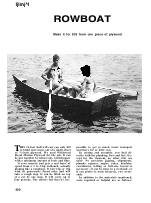The is the first of the boats that I hope to build one a year of.
To the right you will find the plans I used, which are quite old but thorough and fairly easy to follow. While I don’t know the author of the plans but he left very little out. All said and done, if I wanted another one, I’d build it again.
What follow is my photo essay with notes.
















